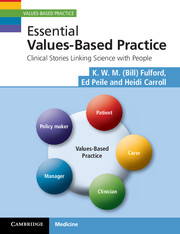Book contents
- Frontmatter
- Review quotes
- Contents
- Foreword
- Acknowledgements
- A bold claim to start this book
- Prologue: linking science with people
- Part 1 Values, individuals and an overview of values-based practice
- Part 2 The clinical skills for values-based practice
- Part 3 Relationships in values-based practice
- Part 4 Science and values-based practice
- Part 5 Bringing it all together
- Postcript: the small change of care
- A bold claim to end this book
- Appendix A Values-based practice summary and definitions of key terms
- Appendix B Values-based practice teaching framework
- Index
Part 3 - Relationships in values-based practice
Published online by Cambridge University Press: 05 June 2012
- Frontmatter
- Review quotes
- Contents
- Foreword
- Acknowledgements
- A bold claim to start this book
- Prologue: linking science with people
- Part 1 Values, individuals and an overview of values-based practice
- Part 2 The clinical skills for values-based practice
- Part 3 Relationships in values-based practice
- Part 4 Science and values-based practice
- Part 5 Bringing it all together
- Postcript: the small change of care
- A bold claim to end this book
- Appendix A Values-based practice summary and definitions of key terms
- Appendix B Values-based practice teaching framework
- Index
Summary
Introduction to Part 3
This part is concerned with the relationships, respectively, between professionals and patients, and between professionals of different kinds working together in multidisciplinary teams.
“Person-centered practice” means different things in different contexts. Chapter 8, through the story of a woman, Brenda Forest, with early breast cancer, shows that in all its various meanings person-centered practice must include attention to the values – the needs, preferences, strengths and above all aspirations – of the particular person concerned. Person-centered practice, the chapter concludes, is nothing if it is not person-values-centered practice.
Multidisciplinary team work has become increasingly the norm in many contexts in the ever more complex environment of modern healthcare. In part, this is because team members from different professions bring with them different skills and experience. In values-based practice, the concept of the multidisciplinary team is extended to include different team values. In Chapter 9, we illustrate the importance of team values in supporting balanced decision-making in a child safeguarding case.
“Person-centered practice” and “multidisciplinary teamwork” are both very much among today's buzz words in health care. There are good reasons for this. Like any buzz word, they can become misused as empty mantras. But person-centered practice represents an important shift of focus away from the priorities of providers and back to the needs of individual patients and their families, while multidisciplinary teamwork is essential for the effective delivery of care that is genuinely person-centered. Values-based practice, as we will see in this part, both draws on and in turn contributes to the multidisciplinary delivery of person-centered care.
- Type
- Chapter
- Information
- Essential Values-Based PracticeClinical Stories Linking Science with People, pp. 97 - 98Publisher: Cambridge University PressPrint publication year: 2012

